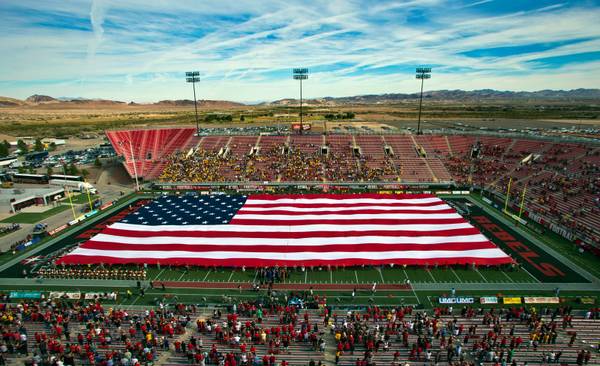Few of the greatest moments in UNLV athletics history reside at the far eastern end of Russell Road in Sam Boyd Stadium.
On a 62-acre land parcel roughly 10 miles west on Russell, the Rebels will share a sparkling new 65,000-seat domed stadium with the Las Vegas Raiders in about three years.
That’s when Sam Boyd might create its most lasting positive impact for UNLV simply by permanently shutting its doors. When the Rebels move into the Raiders facility to play their home football games, the closure of Sam Boyd could net UNLV up to $35 million in compensation for lost revenue from the Las Vegas Stadium Authority over a 10-year period.
What then becomes of the more than 69 acres on which the current stadium stands remains unknown. UNLV President Len Jessup will present options to the Nevada Board of Regents on the subject Thursday at the request of the board.
“We’re wanting to assure the board that we as the university can’t make any decisions on the future of Sam Boyd Stadium without coming back to them with a plan they would have to act on,” said Gerry Bomotti, UNLV senior vice president for finance and business.
Regent Trevor Hayes, however, sees little new information in the update provided in the board’s agenda packet.
“I’m surprised they’re giving us an update that’s not really an update,” Hayes said. “This update could’ve been written a year ago or immediately following the (Nevada Legislature) special session.”
Bomotti identified the potential sale of the land for development and a possible land swap with Clark County as options for the parcels. The county transferred ownership of the stadium land to the regents in 1985 and still owns another adjacent 92 acres that is leased to the regents for Sam Boyd parking. County officials did not have much interest in such a trade in discussions two years ago, Bomotti said, but local real estate and development conditions have improved drastically since then.
“The whole gamut of options is open,” Bomotti said.
One idea initially identified but later scrapped would have explored whether the Raiders might want the stadium and land for a practice facility, but that consideration ended quickly.
“The Raiders don’t like that location,” Bomotti said. “It’s so far off as what they see as the beaten path. They’re looking at some other locations, as I understand it.”
Raiders officials appear to prefer a location adjacent to the 215 Beltway to allow players and staff living in Summerlin or Green Valley easy driving access.
Sam Boyd Executive Director Mike Newcomb declined to comment on potential uses for Sam Boyd and the surrounding land, saying only that the stadium would close upon the opening of the Raiders stadium as laid out in Senate Bill 1. That is the state legislation approved in October that allots $750 million in public funding toward the $1.9 billion building.
Within that law is language allowing UNLV to receive up to $3.5 million per year over 10 years to make up for income lost by Sam Boyd’s closure. To calculate exactly how much money the university can claim, UNLV officials will work with the Stadium Authority to establish a baseline year no earlier than fiscal year 2015-16, then measure both income stripped by losing Sam Boyd and monies gained through the use of the new stadium.
Bomotti said that process began recently and will require a significant amount of additional information, including the terms of the as-yet unfinished stadium shared-use agreement between UNLV and the Raiders stadium events company.
“We’re working on those models now, but a lot of assumptions have to be made,” Bomotti said. “One is how many people will come to football games at the new stadium and what might we get out of suites.”
The 69 acres owned by the regents includes a 58-acre parcel and an 11-acre parcel. The smaller segment originally included restrictions on use for recreation and public purposes, but UNLV officials are applying for a ruling from the Bureau of Land Management to find out if those restrictions expired.
Jay Heller, president of the local chapter of commercial real estate development association NAIOP and a Commercial Alliance Las Vegas board member, sees such a sizable parcel of land as hugely valuable if current building conditions continue until it would come up for sale in a few years.
“There is a scarcity of large developable land that has infrastructure and utilities to the site,” Heller said. “Seventy-plus acre sites that are actual shovel-ready are rare. Even knowing that, to have the Board of Regents wanting to find highest and best use, commercial development would probably lose out to a homebuilder who could pay more for the land.”
The Board of Regents meeting begins Thursday morning at UNR.


Join the Discussion:
Check this out for a full explanation of our conversion to the LiveFyre commenting system and instructions on how to sign up for an account.
Full comments policy